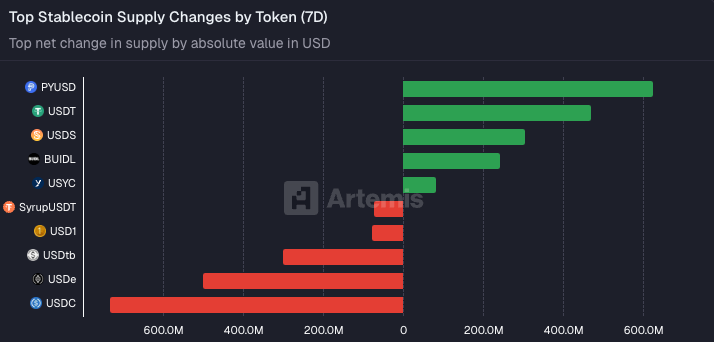PayPals PYUSD just had a breakout week. The dollar-pegged stablecoin added $625 million in new tokens since Nov. 10, a 22% jump in supply that pushes PYUSD to the No. 6 spot in Decentralized Finance (DeFi) by size.
Most of that growth landed on Ethereum. PYUSDs circulating supply on Ethereum now totals $2.38 billion, which is nearly 70% of all PYUSD in existence, according to DeFiLlama.
Key numbers at a glance
- New PYUSD minted since Nov. 10: $625M (+22% week over week)
- PYUSD on Ethereum: $2.38B (~70% of total PYUSD)
- Share of the overall stablecoin market: just over 1% of $303B
- Market leaders: USDT at $183B, USDC at $74B
PYUSD leads weekly growth
Among major stablecoins, PYUSD posted the biggest weekly expansion. Over the past month, it ranks third for net growth, behind Tethers USDT and Skys USDS.

Why this matters
Stablecoins are cryptos cash equivalents. They aim to track the U.S. dollar and make it easier to move money between exchanges, apps, and wallets without leaving crypto. More PYUSD in circulation suggests bigger demand from traders, market makers, and potentially PayPals own users as they bridge between traditional payments and blockchain.
As PYUSD grows past 1% of the market, competition is heating up in a space long dominated by USDT and USDC. A larger share could help PayPal broaden on-ramps for newcomers and deepen liquidity in DeFi apps where PYUSD trades or is used as collateral.
Where the growth is
The new issuance is concentrated on Ethereum, the most active smart-contract network. That concentration can boost liquidity in Ethereum-based decentralized exchanges but also ties PYUSDs activity to Ethereums fees and network conditions.
Background: a minting mishap, then momentum
Last month, Paxosthe firm that issues PYUSDaccidentally minted $300 trillion worth of PYUSD on Ethereum in a test gone wrong. The tokens were quickly burned, and balances were unaffected. The episode didnt slow growth: new minting resumed as demand picked up.
How minting works (in plain English)
When users or partners bring dollars to the issuer, new stablecoins are created, or "minted." When they cash out, the issuer destroys, or "burns," those tokens. The latest wave of PYUSD minting means more dollars flowed in than out over the past week.
What to watch next
- Adoption in DeFi: Will more lending markets and liquidity pools list PYUSD for yields and trading?
- Exchange pairs: New PYUSD trading pairs could drive volumes and make it easier to move between assets.
- Issuer discipline: After the Paxos error, operational transparency and controls will stay in focus.
- Regulatory signals: Oversight of dollar-backed tokens could shape how fast PYUSD scales from here.
The bottom line
PYUSDs $625M weekly mint and 22% supply jump mark a clear acceleration. With most of its supply on Ethereum and a growing footprint across crypto, PayPals stablecoin is emerging as a meaningful, if still small, player in a $303B market led by USDT and USDC.
